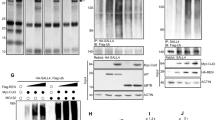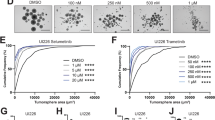Abstract
Dysregulated signal transduction through the notch pathway has been noted in human and mouse medulloblastoma studies. Gamma secretase inhibitors (GSIs) impair notch signaling by preventing the cleavage of transmembrane notch proteins into their active intracellular domain fragments. Previous studies have shown that GSI treatment caused apoptosis and impaired medulloblastoma cell engraftment in xenograft systems. In this study, we used in vivo genetic and pharmacologic approaches to quantify the contribution of notch signaling to sonic hedgehog (shh)-activated mouse medulloblastoma models. In contrast to prior in vitro studies, pharmacologic inhibition of notch pathways did not reduce the efficiency of medulloblastoma xenotransplantation nor did systemic therapy impact tumor size, proliferation, or apoptosis in genetically engineered mouse medulloblastoma models. The incidence and pathology of medulloblastomas driven by the SmoA1 transgene was unchanged by the bi-allelic absence of Notch1, Notch2, or Hes5 genes. These data show that notch signaling is not essential for the initiation, engraftment, or maintenance of sonic hedgehog pathway-driven medulloblastomas.
This is a preview of subscription content, access via your institution
Access options
Subscribe to this journal
Receive 50 print issues and online access
$259.00 per year
only $5.18 per issue
Buy this article
- Purchase on Springer Link
- Instant access to full article PDF
Prices may be subject to local taxes which are calculated during checkout




Similar content being viewed by others
References
Cau E, Gradwohl G, Casarosa S, Kageyama R, Guillemot F . (2000). Hes genes regulate sequential stages of neurogenesis in the olfactory epithelium. Development 127: 2323–2332.
Eberhart CG . (2007). In search of the medulloblast: neural stem cells and embryonal brain tumors. Neurosurg Clin N Am 18: 59–69, viii-ix.
Fan X, Matsui W, Khaki L, Stearns D, Chun J, Li YM et al. (2006). Notch pathway inhibition depletes stem-like cells and blocks engraftment in embryonal brain tumors. Cancer Res 66: 7445–7452.
Fan X, Mikolaenko I, Elhassan I, Ni X, Wang Y, Ball D et al. (2004). Notch1 and notch2 have opposite effects on embryonal brain tumor growth. Cancer Res 64: 7787–7793.
Fortini ME . (2009). Notch signaling: the core pathway and its posttranslational regulation. Dev Cell 16: 633–647.
Gilbertson RJ, Ellison DW . (2008). The origins of medulloblastoma subtypes. Annu Rev Pathol 3: 341–365.
Goodrich LV, Milenkovic L, Higgins KM, Scott MP . (1997). Altered neural cell fates and medulloblastoma in mouse patched mutants. Science 277: 1109–1113.
Hallahan AR, Pritchard JI, Hansen S, Benson M, Stoeck J, Hatton BA et al. (2004). The SmoA1 mouse model reveals that notch signaling is critical for the growth and survival of sonic hedgehog-induced medulloblastomas. Cancer Res 64: 7794–7800.
Hatton BA, Villavicencio EH, Tsuchiya KD, Pritchard JI, Ditzler S, Pullar B et al. (2008). The Smo/Smo model: hedgehog-induced medulloblastoma with 90% incidence and leptomeningeal spread. Cancer Res 68: 1768–1776.
Ingram WJ, McCue KI, Tran TH, Hallahan AR, Wainwright BJ . (2008). Sonic Hedgehog regulates Hes1 through a novel mechanism that is independent of canonical Notch pathway signalling. Oncogene 27: 1489–1500.
Julian E, Dave R, Robson J, Hallahan AR, Wainwright BJ . (2010). Canonical notch signaling is not required for the growth of hedgehog pathway induced medulloblastoma. Oncogene (e-pub ahead of print 26 April 2010; doi:10.1038/onc.2010.101).
Lewis SJ, Smith AL, Neduvelil JG, Stevenson GI, Lindon MJ, Jones AB et al. (2005). A novel series of potent gamma-secretase inhibitors based on a benzobicyclo[4.2.1]nonane core. Bioorg Med Chem Lett 15: 373–378.
McCright B, Lozier J, Gridley T . (2006). Generation of new Notch2 mutant alleles. Genesis 44: 29–33.
Pomeroy SL, Tamayo P, Gaasenbeek M, Sturla LM, Angelo M, McLaughlin ME et al. (2002). Prediction of central nervous system embryonal tumour outcome based on gene expression. Nature 415: 436–442.
Radtke F, Wilson A, Stark G, Bauer M, van Meerwijk J, MacDonald HR et al. (1999). Deficient T cell fate specification in mice with an induced inactivation of Notch1. Immunity 10: 547–558.
Sasai K, Romer JT, Lee Y, Finkelstein D, Fuller C, McKinnon PJ et al. (2006). Shh pathway activity is down-regulated in cultured medulloblastoma cells: implications for preclinical studies. Cancer Res 66: 4215–4222.
Schouwey K, Beermann F . (2008). The Notch pathway: hair graying and pigment cell homeostasis. Histol Histopathol 23: 609–619.
Solecki DJ, Liu XL, Tomoda T, Fang Y, Hatten ME . (2001). Activated Notch2 signaling inhibits differentiation of cerebellar granule neuron precursors by maintaining proliferation. Neuron 31: 557–568.
Sparey T, Beher D, Best J, Biba M, Castro JL, Clarke E et al. (2005). Cyclic sulfamide gamma-secretase inhibitors. Bioorg Med Chem Lett 15: 4212–4216.
Wall DS, Mears AJ, McNeill B, Mazerolle C, Thurig S, Wang Y et al. (2009). Progenitor cell proliferation in the retina is dependent on Notch-independent Sonic hedgehog/Hes1 activity. J Cell Biol 184: 101–112.
Weiner HL, Bakst R, Hurlbert MS, Ruggiero J, Ahn E, Lee WS et al. (2002). Induction of medulloblastomas in mice by sonic hedgehog, independent of Gli1. Cancer Res 62: 6385–6389.
Zeltzer PM, Boyett JM, Finlay JL, Albright AL, Rorke LB, Milstein JM et al. (1999). Metastasis stage, adjuvant treatment, and residual tumor are prognostic factors for medulloblastoma in children: conclusions from the Children's Cancer Group 921 randomized phase III study. J Clin Oncol 17: 832–845.
Acknowledgements
We are grateful to Dr Francois Guillemot for providing the Hes5-null mice, to Freddy Radtke for the notch1 conditional knockout mice, to Thomas Gridley for the notch2 conditional knockout mice, and to Dr Irwin Bernstein for providing the 18G anti-Notch antibody and advice. The gamma secretase inhibitor MRK-003 was provided by Merck Research Laboratories, which also provided partial funding for the studies. This work was supported by NIH Grants 5R01CA112350-04, 5R01CA114567-04, 5T32CA009351, and 5K12CA076930.
Author information
Authors and Affiliations
Corresponding author
Ethics declarations
Competing interests
Merck Research Laboratories provided the GSI MRK-003 and partial funding for the studies, but did not have a role in designing the studies or collecting or analyzing the resulting data. Merck Research Laboratories reviewed the manuscript before its submission to Oncogene and stated no conflict in including all data and results for publication.
Additional information
Supplementary Information accompanies the paper on the Oncogene website
Rights and permissions
About this article
Cite this article
Hatton, B., Villavicencio, E., Pritchard, J. et al. Notch signaling is not essential in sonic hedgehog-activated medulloblastoma. Oncogene 29, 3865–3872 (2010). https://doi.org/10.1038/onc.2010.142
Received:
Revised:
Accepted:
Published:
Issue Date:
DOI: https://doi.org/10.1038/onc.2010.142
Keywords
This article is cited by
-
What underlies the diversity of brain tumors?
Cancer and Metastasis Reviews (2013)
-
A knockdown of Maml1 that results in melanoma cell senescence promotes an innate and adaptive immune response
Cancer Immunology, Immunotherapy (2013)
-
A contemporary review of molecular candidates for the development and treatment of childhood medulloblastoma
Child's Nervous System (2013)



